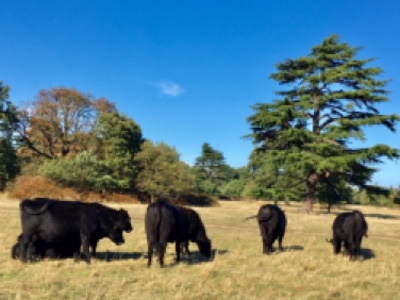Cows were introduced by Spelthorne Council into Sunbury Park in Sept 2015. Since then, each year, they have been a feature of the park from April to September.
At the outset, I think the reaction was one of suspicion, as many of the park users, including dog walkers were worried of the effects the cows may have on their access and enjoyment of the area. Since that time however, that worry has largely been dissipated and all users of the park do so safely.
I was appointed chair of the Friends of Sunbury Park in the summer of 2018 and, as the cows are due to return very shortly for 2019, thought it worthwhile to remind ourselves as to why they are present for much of the spring and summer.
As many users of Sunbury park will know, it consists of a central grassy parkland area, (containing around 20 species of grass), surrounded by a dense woody, bramble filled edge with more dense areas of woodland in the south and west. It had long been mooted that without some form of control, the brambles, and other invasive weeds and shrubs would continue to encroach into the central park and reduce access and diversity or at least make it harder. Indeed, the path on the north side of the park has moved inwards by several metres because of the continual bramble encroachment. It was partly to help solve this problem that the cows (Aberdeen Angus) were introduced.
It had been previously found that cows could be used to help with overall management of the park. They provide an excellent natural cleaning source and can be used to manage the removal of bracken, bramble and nettles. By using cows, we are utilising a more sustainable and natural way to manage the land to help increase diversity. It also means that there is a reduction in the need for chemical treatments and the use of machinery is not required, especially in the places, such as the woodland areas, where it would be difficult to introduce such measures.
When the cows are grazing, they keep down the choking invasive tall grasses, scrub and, sapling trees in environmentally sensitive areas. Anybody walking through the woodland edges, perhaps looking at the abundant plant life there, will have noticed how much more open and diverse the sward is since they arrived.
As the cows eat large volumes, they tend to rip up the sward rather than nibble plants. This means that they are therefore helping to open up the pasture and this clearance allows for a more species-rich spread of other grasses and wild flowers that may be in the seedbank.
It also encourages insect-friendly species of plant to flourish. Cattle also turn over the ground with their hooves, which opens up habitable niches for invertebrates and, of course, produce natural fertilisers for the plant life. Their dung also provides the perfect nutrients for many species of beetles, flies and other invertebrates, which in turn are a food source for our bird, bat and other small mammal populations.
In the spring of 2019, The Friends of Sunbury Park will, in conjunction with Spelthorne Council, be having a new 5-10 year management plan written by an independent ecologist that will concentrate on birds, plants, trees and invertebrates, the diversity of all which can be promoted by the use of a conservation grazing regime.
The results will guide us in our management activities of the park over the next decade. By using the cows as part of that plan, we will continue to use sustainable techniques that will bring increased diversity to the site and will provide more enjoyment and natural interest for all its users.
By John Maxen

